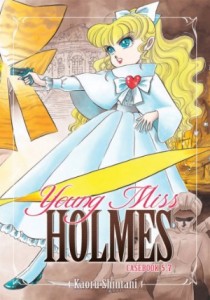By Kaoru Shintani. Released in Japan as “Christie High Tension” by Media Factory, serialized in the magazine Comic Flapper. Released in North America by Seven Seas.
The Young Miss Holmes series wraps up here with an omnibus of the final three volumes, and also takes a departure from canon, as only the first story, “The Adventure of the Solitary Cyclist”, is a Watson story published by Conan Doyle. That said, some of the titles of the remaining stories here may be familiar with Holmes and Watson, particularly the “Canary Trainer” mentioned in “The Adventure of Black Peter”, and the infamous “Giant Rat of Sumatra”, mentioned in the “Adventure of the Sussex Vampire” story. Shintani makes a decent effort at leaving the Holmes canon, and it allows him to do a bit more with Christie than simple sleuthing, particularly in the finale, which is basically an action movie with very little detecting.
The canonical Holmes story, Solitary Cyclist, does a decent job of having Christie and Sherlock join forces. Violet Smith is an old friend of Grace, Christie’s governess. Christie herself is chomping at the bit to become more independent, while still retaining a childlike air (particularly in the Circus chapters). That said, she’s not only more mature than most girls her age but far more modern, discussing how she has no desire to be a young lady the way the Victorians see them, and is already taking her savings and starting a pension plan to allow her servants to retire happily. It’s a good way to try to drag Holmes into the 21st century a bit, while still maintaining the charm of the original. (That said, I could have done without the appearance of Queen Victoria herself, in the weakest part of the book.)
The book is not faultless, of course. There is less nudity and gore than the first two omnibuses, but there’s still lots of corpses for an All-Ages rating, and Comic Flapper and Shintani still seem to sexualize Christie more than is necessary on a few title pages. The use of ‘moneylenders’ once or twice comes with some Victorian stereotypes, although it’s not really bad unless you’re looking for it. (Indeed, most of the villains here suffer from “I am ugly and therefore a villain” disease, which is quite common in comics and manga alike.) “The Dying Message” and “The Flying Dancer” aren’t too bad, but are weaker than the other stories we see here.
The Canary Trainer story is easily the creepiest of the book, featuring murder, suicide, child slavery, hypnotic suggestion, and child prostitution. It also merges Christie and Holmes the best of the five stories seen here, as they start out pursuing two totally different cases that only turn out to be the same thing right near the end. However, in a shocking display of canon ignorance, Shintani may have drawn Mycroft Holmes as slim. Luckily, there’s an out: everyone who says “that must have been Mycroft” didn’t actually see him. Perhaps it was Sherringford. Let’s go with that.
Things come to a head with the 7th volume/last third of the book, The Giant Rat of Sumatra. This helps to avoid the stereotype of “foreign villains” by sending a troup of good guys from India to help protect Christie from the thuggee bad guys. They are, of course, led by a young woman who is basically the Indian version of Christie, complete with tomboy mannerisms and snarky retainers. She’s good in a fight, however, which is a bonus, as Christie decides to simply go to ground in her mansion and let the villains come to her. Which they do, in one big final conflagration.
The series ends with the return of Christie’s parents, which marks a good stopping point – I’m sure they won’t totally stop her getting into adventures, but no doubt she will have to slow down a little. Shintani is currently writing a sequel, Christie London Massive, featuring a 17-year-old Christie, a whole new cadre of battle maids (led by Nora, no fear, she’s still there), and perhaps a familiar adversary of Sherlock Holmes thrown into the mix. Of course, that’s Japan. Whether it comes out here or not depends on how well the print and E-Book versions do. I had a ball reading them, particularly as a Holmes fan, and definitely recommend picking up the whole series.
Also, there is a dodo. For some reason.



